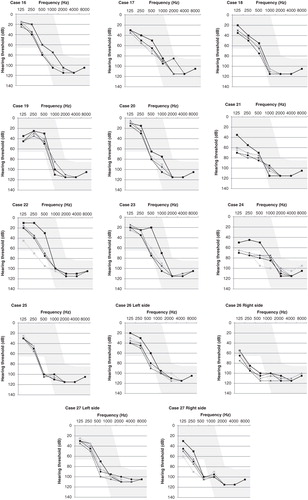Abstract
Conclusions: Our results indicated that electric acoustic stimulation (EAS) is beneficial for Japanese-speaking patients, including those with less residual hearing at lower frequencies. Comparable outcomes for the patients with less residual hearing indicated that current audiological criteria for EAS could be expanded. Successful hearing preservation results, together with the progressive nature of loss of residual hearing in these patients, mean that minimally invasive full insertion of medium/long electrodes in cochlear implantation (CI) surgery is a desirable solution. The minimally invasive concepts that have been obtained through EAS surgery are, in fact, crucial for all CI patients. Objectives: This study was conducted to evaluate hearing preservation results and speech discrimination outcomes of hearing preservation surgeries using medium/long electrodes. Methods: A total of 32 consecutive minimally invasive hearing preservation CIs (using a round window approach with deep insertion of a flexible electrode) were performed in 30 Japanese patients (two were bilateral cases), including patients with less residual hearing. Hearing preservation rates as well as speech discrimination/perception scores were investigated on a multicenter basis. Results: Postoperative evaluation after full insertion of the flexible electrodes (24 mm, 31.5 mm) showed that residual hearing was well preserved in all 32 ears. In all patients, speech discrimination and perception scores were improved postoperatively.
Introduction
Hearing preservation with electric acoustic stimulation (EAS) is a new trend for patients with residual hearing at the lower frequencies. Recent techniques, including round window insertion [Citation1], use of minimally invasive electrodes [Citation2,3], and postoperative steroid administration [Citation4], enable hearing preservation rates of around 90–100% [Citation5–11]. We demonstrated in our previous report that hearing preservation can be achieved even in the presence of a long electrode covering the residual hearing region [Citation12]. This is an extremely important observation not only for EAS, but also because of the advantage of the electrode being in place to cover future hearing deterioration, which is very likely to happen as hearing loss in almost all the candidates is more or less progressive. A recent series of studies in different centers further confirmed that hearing preservation could be possible with full insertion of a longer electrode [Citation4,6,8,9,12–15].
When performing the hearing preservation surgery, together with the natural course of progressive hearing loss, the surgeon should keep in mind that hearing threshold shift is unavoidable in the majority of cases after insertion of an electrode. To choose the optimal electrode for each individual, detailed data of hearing threshold shifts on a multicenter basis are crucial.
We have previously published a report on short-term hearing preservation results of five cases included in the current paper [Citation12]. The present study expanded the duration of observation, the number of patients, and the number of the centers.
In this study, based on the minimally invasive concepts and using a round window insertion, we evaluated (1) hearing preservation results in 32 consecutive surgeries in 30 patients (including 2 bilateral cases), (2) the postoperative threshold shift of air conduction and bone conduction, (3) whether or not EAS is beneficial for Japanese-speaking patients, and (4) whether or not EAS is beneficial even for patients who do not meet the current audiological EAS criteria.
Material and methods
We performed 32 consecutive hearing preservation surgeries in 30 patients with residual hearing () who all had late or post-lingual onset, high-frequency involved sensorineural hearing loss. The subjects were divided into two groups according to the length of the electrode used. Group 1 consisted of 29 ears in 27 patients who received MEDEL PULSAR® with a 24 mm FLEX24® device. Among them were 24 patients (case nos. 1–24) who participated in a multicenter clinical trial in Japan and fulfilled the audiological criteria for EAS, slightly modified from that of a multicenter trial in the EU. (The criteria were: pure-tone hearing levels bilaterally at 65 dBHL for 125 Hz, 250 Hz, and 500 Hz; 80 dBHL at 2000 Hz; and 85 dBHL at 4000 and 8000 Hz; as well as minimal benefit from conventional hearing aids, i.e. monosyllable scores in quiet under 60% in the best aided condition.) The remaining three patients (case nos. 25–27; two of which were bilateral cases) had hearing levels only partially fulfilling the above EAS criteria, therefore were not included in the clinical trial. Group 2 comprised three ears in three patients who had less residual hearing and received longer (31.5 mm length) electrodes. One patient (no. 28) received a MEDEL COMBI40+® with a 31.5 mm Standard electrode. Two patients (nos. 29 and 30) received MEDEL PULSAR® with a 31.5 mm FLEXSOFT® electrode. A round window approach was used and full insertion of the electrode was achieved in all 32 surgeries.
Table I. Clinical features of cases undergoing electric acoustic stimulation (EAS).
The ages of the patients at time of surgery ranged from 21 to 71 years and all had late or post-lingual onset hearing loss at higher frequencies that was slowly progressive, starting at age 3–52 years ().
The round window approach was applied to reduce the insertion damage of the cochlea. The surgeries were performed by four surgeons (). Intraoperative and postoperative systemic dexamethasone treatment was given according to our protocol [Citation12], i.e. intraoperative infusion of dexamethasone sodium phosphate (8 mg) applied before drilling of the bony edge of the round window niche and postoperative dexamethasone treatment administered for 6 days (8 mg, 8 mg, 4 mg, 4 mg, 2 mg, and 2 mg, respectively). The insertion depth of the electrode and the corresponding frequencies were estimated using postoperative X-ray (X-ray digital linear tomosynthesis).
EAS fitting
The frequency at which the audiogram surpassed 65 dBHL hearing loss was determined and the CI low frequency crossover point was set at that frequency point for fitting the EAS.
Audiometric evaluation
Audiometric evaluation from 125 to 8000 Hz was performed preoperatively and at 1, 3, 6, and 12 months after the initial EAS stimulation. Pure-tone hearing was evaluated at 4 weeks postoperatively; at the time of CI and EAS fittings; as well as at 3, 6, and 12 months postoperatively. Proper masking was applied to the contralateral ear and bone-conduction thresholds were used.
To evaluate speech perception outcomes, speech discrimination scores (using the 67S Japanese monosyllable test) and speech perception scores (using the Japanese CI2004 word and sentence test) were used. Subjects sat 1 meter away from the sound source facing 0° azimuth and recorded monosyllable words in quiet were presented in the sound field at 65 dB SPL. Three listening conditions were used: hearing aid alone, CI alone, and combined EAS. Each subject also underwent hearing in noise-testing using a monosyllable, word, and sentences protocol. A 10 dB signal-to-noise ratio (SNR) was used for subsequent testing determined at 1, 3, 6, and 12 months after the initial EAS stimulation.
This study was approved by the Ethics Committee of Shinshu University School of Medicine as well as the respective ethical committees of the other participating institutions and prior written consent was obtained from each patient after a full explanation of the study.
Results
The current study included five cases (nos. 25, 26, 27, 28, and 29) from our previous report [Citation12] on short-term hearing preservation results, and expanded the duration of observation, the number of patients, and the number of centers involved.
Hearing preservation
Achievement of full insertion was confirmed by combined postoperative imaging with the referential tonotopic map and the corresponding frequencies and the depth of the electrode were evaluated (see Usami et al. [Citation12] for examples).
Overall, postoperative evaluation after deep insertion (24 or 31.5 mm) of the electrodes showed that residual hearing was well preserved in all 32 ears.
Individual preoperative and postoperative audiograms for group 1 are shown in . Up to the 12-month follow-up, postoperative evaluation after full insertion of the electrodes showed that hearing in the low frequencies was well preserved in all 24 ears, but 1 patient (case no. 2) lost hearing at more than 6 months following surgery without any episode. The average audiograms for group 1 are shown in . Details of hearing threshold shift are indicated in . Change in air conduction was 14.1 dB in 125 Hz, 19.7 dB in 250 Hz, 27.4 dB in 500 Hz, and 11.6 dB in 1000 Hz. Change in bone conduction was 8.3 dB in 250 Hz, 16.7 dB in 500 Hz, and 5.0 dB in 1000 Hz, respectively.
Figure 1. Hearing preservation results of group 1 with FLEX24 electrode. The lines indicate preoperative, and 1, 3, 6, and 12 months postoperative audiograms. Shadow indicates the audiological criteria for electric acoustic stimulation (EAS) clinical trial (patient nos. 1–24 fulfilling the audiological criteria for EAS, nos. 25–27 not fulfilling the criteria for the clinical trial for EAS).
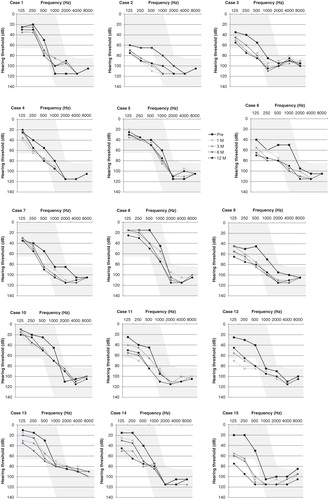
Figure 2. (A) Average audiogram of group 1. The lines indicate preoperative, 1, 3, 6, and 12 months postoperative audiograms. Note that good hearing preservation could be achieved. (B) Hearing level of group 1 with electric acoustic stimulation (EAS).
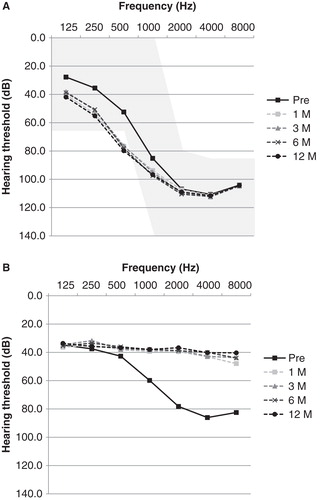
Table II. Average hearing thresholds of electric acoustic stimulation (EAS) patients in group 1.
Low-frequency (250–1000 Hz) pure-tone thresholds dropped at the initial cochlear implant activation at 1 month postoperatively. In particular, hearing deterioration at 500 Hz was evident compared with 250 Hz or 1000 Hz. After initial deterioration, pure-tone thresholds were maintained until the 12-month evaluation.
In group 2, in which there was less residual hearing, it was also well preserved. Individual preoperative and postoperative audiograms are shown in and the average audiogram is shown in . Change in air conduction was 20.0 dB in 125 Hz, 25.0 dB in 500 Hz, and 8.3 dB in 500 Hz. Bone conduction was 10.8 dB in 250 Hz. Details of hearing threshold shift for group 2 are indicated in .
Figure 3. Hearing preservation results of group 2 (cases with less residual hearing and receiving longer electrodes (no. 28 with standard electrode, nos. 29 and 30 with FLEXSOFT electrode). The lines indicate preoperative, and 1, 3, 6, and 12 months postoperative audiograms. Note that good hearing preservation could be achieved.
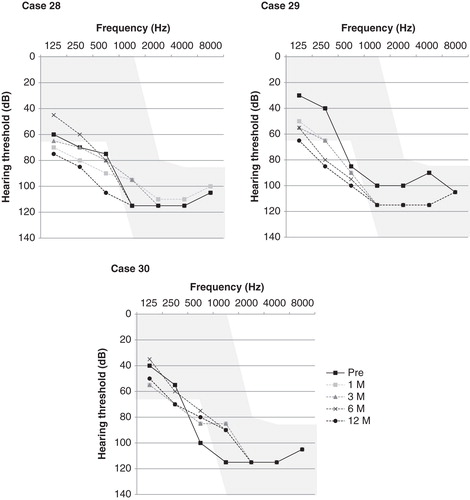
Figure 4. (A) Average audiogram of group 2. The lines indicate preoperative, and 1, 3, 6, and 12 months postoperative audiograms. Note that good hearing preservation could be achieved. (B) Hearing level of group 2 with electric acoustic stimulation (EAS).
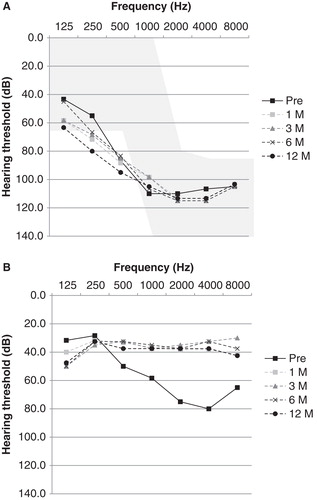
Table III. Average hearing thresholds of electric acoustic stimulation (EAS) patients in group 2.
EAS fitting
In two subjects (case nos. 2 and 15), residual hearing was not sufficient to utilize acoustic stimulation. Cochlear implant fitting using a full-frequency map and subsequent bimodal mode of stimulation with a contralateral hearing aid was used. Their cochlear implant alone monosyllable perception scores were 50% and 40% after 1 year, and 75% and 70% in the bimodal setting, respectively. We excluded these two cases from the evaluation of the speech perception outcome. For all other patients, an EAS speech processor (DUET II®) was applied. Postoperative hearing levels of groups 1 and 2 with EAS are shown in and , respectively.
Speech perception outcome
Improvement of speech discrimination and perception scores was seen in both groups ( and ). In group 1, the average monosyllable discrimination score in quiet (67S 65 dBSPL) was improved from 24.1% preoperatively with hearing aid to 67.4% with EAS 12 months after the first fitting. This postoperative improvement occurred gradually from 48.4% at 1 month to 67.4% at 12 months () and was mainly based on the adaptation of electrical stimulation, because in a comparison of monosyllable discrimination scores in three conditions (acoustic stimulation only (AS only), electric stimulation only (ES only) and EAS), acoustic stimulation scores changed only slightly from 13.8% to 18.1% at 12 months after the first fitting, but electrical stimulation improved from 35.0% to 55.4%. Also, the EAS condition showing the best performance for monosyllable discrimination revealed that acoustic stimulation combined with electrical stimulation increases perception ability (EAS results were significantly better than ES only; p < 0.001, paired t test). Similar results were observed in monosyllable, word, and sentence perception tests in noise. The results for monosyllable perception in noise were improved from 21.0% preoperatively with hearing aid to 60.2% with EAS 12 months after the first fitting. This postoperative improvement occurred gradually from 36.9% at 1 month to 60.2% at 12 months. Also, EAS results (60.2% correct) were significantly better than AS only (13.9% correct) and ES only (46.0% correct) results (p < 0.001 and p = 0.009, paired t test). The average word and sentence perception test score in noise improved from 35.8%, and 51.3% to 77.0%, and 88.2%, respectively. In both word and sentence perception tests, EAS showed the best results (). EAS results were significantly better than the ES only results (p = 0.002 for word and p = 0.01 for sentence, paired t test).
Figure 5. Speech discrimination and perception scores of group 1 (with FLEX24 electrode). Speech discrimination and perception scores were improved postoperatively with electric acoustic stimulation (EAS). SNR, signal-to-noise ratio.
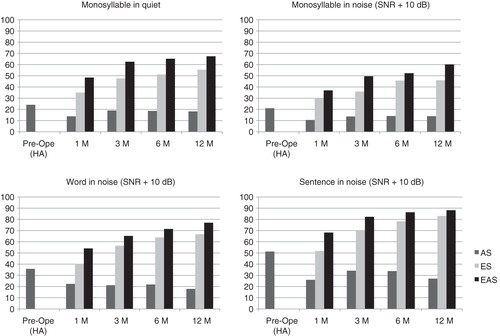
Figure 6. Speech discrimination and perception scores of group 2 (standard electrode or FLEXSOFT electrode with less residual hearing). Speech discrimination and perception scores were improved postoperatively with electric acoustic stimulation (EAS). SNR, signal-to-noise ratio.
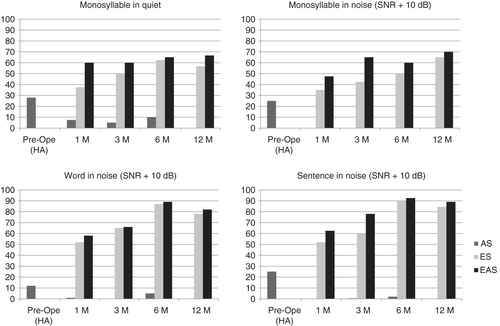
Similar results were obtained for the patients in group 2, who had less residual hearing and received longer (31.5 mm length) electrodes. Good performance after EAS was observed. The average monosyllable discrimination score in quiet (67S 65 dBSPL) was improved from 28% preoperatively with hearing aid to 66.7% with EAS 12 months after the first fitting (). The results for monosyllable, word, and sentence perception in noise were improved from 25%, 12%, and 25%, preoperatively with hearing aid to 66.7%, 82%, and 89% with EAS 12 months after the first fitting. In all of the conditions, EAS showed the best results ().
Discussion
We first consider hearing preservation. We combined postoperative imaging with the referential tonotopic map and clearly showed that even with the use of a long electrode covering the residual hearing region it is possible to achieve hearing preservation with EAS.
Overall, hearing preservation as well as speech perception data obtained in this study correlate well with recent reports [Citation5–11]. As to hearing preservation, residual hearing was well preserved even after deep insertion (full insertion of 24 mm or 31.5 mm length electrodes). As in other reports, hearing thresholds dropped at the initial cochlear implant activation 1 month postoperatively. In particular, hearing deterioration at 500 Hz was evident compared with 250 Hz or 1000 Hz. After initial deterioration, pure-tone thresholds were stable until 12 months. In particular, air-conduction hearing was elevated compared with bone-conduction hearing, suggesting that this initial deterioration may be most likely due to changes in cochlear micromechanics rather than acute acoustic trauma. This phenomenon could be explained by the slight lifting of the basilar membrane in the middle turn that was seen in a temporal bone study [Citation16].
In contrast, a slight hearing improvement could also be observed in some cases (group 1, case no. 1, 1000 and 2000 Hz; group 1, case no. 10, 2000 Hz; group 1, case no. 21, 1000 Hz; group 1, case no. 24, 2000 Hz; group 2, case no. 28, 1000 Hz; group 2, case no. 30, 500 and 1000 Hz), as seen in the preliminary data we have previously reported [Citation12]. This phenomenon was constant until the 12-month evaluation, suggesting that this was not a measuring error but true improvement. This is probably due to alterations of the basilar membrane behavior occurring after electrode insertion.
We turn now to speech perception outcome. Hearing preservation could be achieved in a high number of patients, and combined EAS provided good speech perception in both quiet and noise. Speech discrimination and perception scores were improved postoperatively with EAS in both of our groups, indicating that (1) EAS is beneficial for Japanese-speaking patients within particular audiogram indications, and (2) EAS is also beneficial for patients with less residual hearing at lower frequencies. In the present study, patients with less residual hearing (case nos. 25–30) showed good results equal to those fulfilling the audiological criteria (case nos. 1–24), indicating that these patients are also good candidates for EAS. The current results indicated that the audiological criteria for EAS should not be limited to the conventional range of audiogram, but also expanded to the patients with less residual hearing.
Hearing loss in the majority of patients with residual hearing at lower frequencies is more or less progressive and therefore they may have fulfilled the audiological criteria for EAS at an earlier date. Actually an audiogram from the past showed that our case no. 27 in group 1 had previously fulfilled the audiological criteria (data not shown) and it is possible that this was also true for case nos. 25, 26, and 28–30. Throughout the selection process for EAS candidates, we have paid attention to the progressive nature of their hearing loss. We need to consider that patients who fulfill the criteria at a certain point possibly may not fit the criteria in the future. In contrast, most of the patients who did not totally meet the audiological criteria for EAS may have fulfilled the criteria several years before. Considering such progressive nature of hearing loss, audiological criteria should not be tightly limited to the conventional criteria for EAS. The present results support the proposition that the criteria could be expanded to include the cases with less residual hearing. Since shallow insertion of short electrodes cannot recruit neurons in the apical region, deeper insertion would be the best solution to compensate for future hearing deterioration at the lower frequencies. However, full insertion with a long/medium electrode for the patients with residual hearing at the low frequencies is still a controversial field because of possible loss of their residual hearing due to mechanical trauma of the corresponding area.
In this study, 24 mm or 31.5 mm electrodes were chosen for all patients. FLEX24 was used for the patients with residual hearing that was more evident, while FLEXSOFT was used for the patients with less residual hearing.
The speed of progression, i.e. rapid or rather stable, may be dependent on the individual etiology. An unresolved issue is the prediction of progressiveness based on the etiology of individual hearing loss, but we have recently reported at least five genes that are responsible for the candidates for EAS, and therefore there is not a single etiology but rather a great genetic heterogeneity involved in this particular type of hearing loss [Citation17–19].
In the present study, the responsible gene (m.1555A>G, TMPRRS3, ACTG1) was identified in 3 of 30 patients () [Citation18,19], and will contribute to such decision-making in the near future.
The benefits of minimally invasive concepts in CI surgery are needed not only for the patients with residual hearing but also for the patients with profound hearing loss without any residual hearing, because structure preservation is critical for (1) future therapeutic interventions including gene therapy and/or regeneration therapy, and (2) vestibular function. If acoustic stimulation is not applicable due to less residual hearing, vestibular function could be a good marker for structure preservation. Our recent study on vestibular function of the patients with EAS clearly demonstrated that the patients have comparatively good vestibular function and it is important to preserve not only residual hearing function but also the vestibular function of the implanted ears, using minimally invasive surgical techniques [Citation20]. The round window approach and soft electrode should be preferred to decrease the risk of damage to vestibular function [Citation12].
Conclusions
EAS is beneficial for Japanese-speaking patients including those with less residual hearing at lower frequencies, indicating that current audiological criteria for EAS can be expanded. Since hearing loss of EAS candidates is more or less progressive, full insertion of medium/long electrodes would be the best solution to compensate for future hearing deterioration at the lower frequencies. The benefits of minimally invasive concepts in CI surgery are crucial not only for the patients with residual hearing but also from the viewpoint of structure preservation in patients with profound hearing loss without any residual hearing.
Acknowledgments
We thank A.C. Apple-Mathews for help in preparing the manuscript. This study was supported by a Health and Labour Sciences Research Grant for Comprehensive Research on Disability Health and Welfare from the Ministry of Health, Labour and Welfare of Japan (S.U.), by the Acute Profound Deafness Research Committee of the Ministry of Health, Labour and Welfare of Japan (S.U.), and by a Grant-in-Aid for Scientific Research from the (then) Ministry of Education, Science and Culture of Japan (http://www.mext.go.jp/english/) (S.U.).
Declaration of interest: The Ministry of Health, Labour and Welfare approved our clinical research for Advanced Medical Technology using electric acoustic stimulation (EAS). Because the EAS devices had not yet been approved for clinical use in Japan, they were supplied by MEDEL. The Shinshu University Conflict of Interest Committee also approved the study. The authors alone are responsible for the content and writing of the paper.
References
- Skarzynski H, Lorens A, Piotrowska A, Anderson I. Preservation of low frequency hearing in partial deafness cochlear implantation (PDCI) using the round window surgical approach. Acta Otolaryngol 2007;127:41–8.
- Adunka O, Kiefer J, Unkelbach MH, Gstoettner W. Development and evaluation of an improved cochlear implant electrode design for electric acoustic stimulation. Laryngoscope 2004;114:1237–41.
- Baumgartner WD, Jappel A, Morera C, Gstöttner W, Müller J, Kiefer J, et al. Outcomes in adults implanted with the FLEXsoft electrode. Acta Otolaryngol 2007;127:579–86.
- Rajan GP, Kuthubutheen J, Hedne N, Krishnaswamy J. The role of preoperative, intratympanic glucocorticoids for hearing preservation in cochlear implantation: a prospective clinical study. Laryngoscope 2012;122:190–5.
- Gstoettner W, Helbig S, Settevendemie C, Baumann U, Wagenblast J, Arnoldner C. A new electrode for residual hearing preservation in cochlear implantation: first clinical results. Acta Otolaryngol 2009;129:372–9.
- Prentiss S, Sykes K, Staecker H. Partial deafness cochlear implantation at the University of Kansas: techniques and outcomes. J Am Acad Audiol 2010;21:197–203.
- Helbig S, Van de Heyning P, Kiefer J, Baumann U, Kleine-Punte A, Brockmeier H, et al. Combined electric acoustic stimulation with the PULSARCI(100) implant system using the FLEX(EAS) electrode array. Acta Otolaryngol 2011;131:585–95.
- Erixon E, Köbler S, Rask-Andersen H. Cochlear implantation and hearing preservation: results in 21 consecutively operated patients using the round window approach. Acta Otolaryngol 2012;132:923–31.
- Tamir S, Ferrary E, Borel S, Sterkers O, Bozorg Grayeli A. Hearing preservation after cochlear implantation using deeply inserted flex atraumatic electrode arrays. Audiol Neurootol 2012;17:331–7.
- Adunka OF, Dillon MT, Adunka MC, King ER, Pillsbury HC, Buchman CA. Hearing preservation and speech perception outcomes with electric-acoustic stimulation after 12 months of listening experience. Laryngoscope 2013;123:2509–15.
- Santa Maria PL, Domville-Lewis C, Sucher CM, Chester-Browne R, Atlas MD. Hearing preservation surgery for cochlear implantation – hearing and quality of life after 2 years. Otol Neurotol 2013;34:526–31.
- Usami S, Moteki H, Suzuki N, Fukuoka H, Miyagawa M, Nishio SY, et al. Achievement of hearing preservation in the presence of an electrode covering the residual hearing region. Acta Otolaryngol 2011;131:405–12.
- Skarzynski H, Lorens A, Zgoda M, Piotrowska A, Skarzynski PH, Szkielkowska A. Atraumatic round window deep insertion of cochlear electrodes. Acta Otolaryngol 2011;131:740–9.
- Helbig S, Baumann U, Hey C, Helbig M. Hearing preservation after complete cochlear coverage in cochlear implantation with the free-fitting FLEXSOFT electrode carrier. Otol Neurotol 2011;32:973–9.
- Bruce IA, Bates JE, Melling C, Mawman D, Green KM. Hearing preservation via a cochleostomy approach and deep insertion of a standard length cochlear implant electrode. Otol Neurotol 2011;32:1444–7.
- Kiefer J, Böhnke F, Adunka O, Arnold W. Representation of acoustic signals in the human cochlea in presence of a cochlear implant electrode. Hear Res 2006;221:36–43.
- Usami S, Miyagawa M, Suzuki N, Moteki H, Nishio S, Takumi Y, et al. Genetic background of candidates for EAS (Electric-Acoustic Stimulation). Audiological Med 2010;8:28–32.
- Usami S, Miyagawa M, Nishio SY, Moteki H, Takumi Y, Suzuki M, et al. Patients with CDH23 mutations and the 1555A>G mitochondrial mutation are good candidates for electric acoustic stimulation (EAS). Acta Otolaryngol 2012;132:377–84.
- Miyagawa M, Nishio SY, Ikeda T, Fukushima K, Usami S. Massively parallel DNA sequencing successfully identifies new causative mutations in deafness genes in patients with cochlear implantation and EAS. PLoS One 2013;8:e75793.
- Tsukada K, Moteki H, Fukuoka H, Iwasaki S, Usami S. Effects of EAS cochlear implantation surgery on vestibular function. Acta Otolaryngol 2013;133:1128–32.


